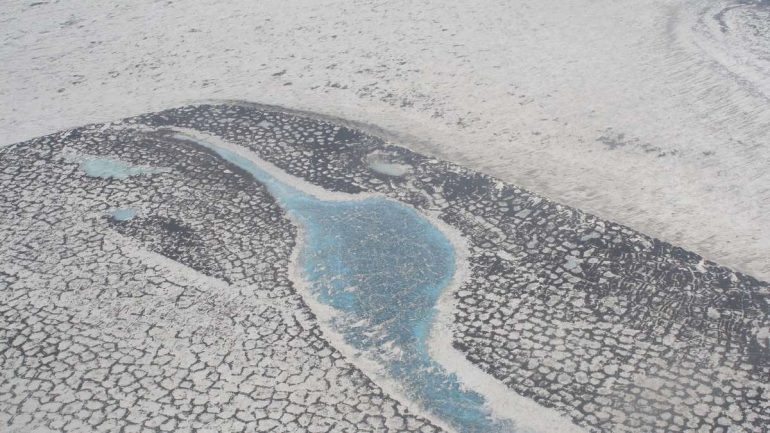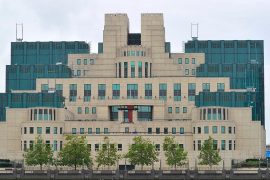Aerial view of the Russian tundra in the Lena Delta showing the typical pattern of permafrost regions.
© Torsten Sachs / Alfred Wegener Institute / dpa
When the temperature rises, people in Russia sometimes feel dire consequences. Roads deserted. Houses can collapse. But what do you do about it?
Norilsk – It is dangerous to live in some regions of Russia now. Here the ground literally breaks under the feet of people. This is happening more and more often, because as temperatures rise, the ground, which freezes to great depths, melts.
The most visible consequences of global warming are large holes in roads and steep slopes. Residential houses are also at risk. “If the permafrost melts, they are in danger of collapsing – an alarming trend at the moment,” says engineer Ali Kerimov. He and other experts in the city of Norilsk now want to make life safe in the Arctic Ocean.
In the industrial town of Norilsk, houses stand on stilts, as in many other places in permafrost regions. “They are 10 to 30 meters deep,” says Kerrimo, director of research and production company Fundament. This construction method prevents buildings from collapsing in the event of temperature fluctuations. In fact. Cracks on the exterior walls of houses indicate that the floor is in motion.
When it gets hotter and hotter, the ground goes deeper – and stakes can barely keep houses from falling, the 55-year-old told the German press agency. If the ground has thawed to a depth of three to five meters, it can sink up to one meter.
This is a serious problem in the world’s largest country in terms of area. About two thirds of the land area in Russia is permanently frozen. This phenomenon is called permafrost. This huge freezer contains huge amounts of plant and animal remains that have not yet been broken down by microbes. These are activated only when the temperature rises and the soil becomes soft.
This is what happens in many areas that are generally known for severe frosts. “Global warming is undeniable now,” says geographer Mathias Ulrich of the University of Leipzig. “The Arctic is the epicenter of global warming. Nowhere else on this planet is it as pronounced.”
It is not without consequences for permafrost. They can be found mainly in Alaska, Canada and Siberia from the Arctic Ocean to partly to the Urals and south to Mongolia. Researchers are concerned that as permafrost melts, large amounts of greenhouse gases such as methane and carbon dioxide could be released. “This in turn will further intensify the greenhouse effect,” Ulrich predicts.
A team led by Bonn scientist Nicolas Froitzheim has now also discovered that a lot of methane was released in two limestone fields in northern Siberia in the scorching summer of 2020. Experts fear that cracks and cave systems in the limestone, previously filled with ice and gas hydrates, have become permeable as a result of warming and harmful gases have entered the atmosphere. The study is published in the journal Proceedings of the National Academy of Sciences (PNAS).
Many people in areas with permafrost are already feeling the immediate consequences of climate change at their doorstep. Buildings, roads and roads become unstable or collapse.
The results are carefully documented in Norilsk, the northernmost city on Earth. 240 homes are on Mayor Dmitry Karasev’s list that have to be completely renovated due to damage or are no longer habitable. Every third building is already deformed. “We have to do everything we can to stabilize the houses so that there are no accidents,” said Karasjo at a recent German-Russian raw materials conference.
Expert Ulrich says that according to current studies, more than 1,000 settlements and cities with about five million people are currently built on Arctic frozen ground. “Forecasts assume that 42 percent of these settlements will be free of permafrost in 30 years.” In Russia alone, 20 percent of all buildings and 19 percent of infrastructure could be affected by the consequences of global warming.
The Russian Environment Ministry estimates that by 2050, the damage caused by the melting of frozen ground could be as much as 57 billion euros. Money that may be missing elsewhere, for example for social spending.
An example from spring 2020 shows that the environment is at risk of pollution. Near Norilsk, more than 21,000 liters of diesel leaked from a damaged tank as the support sank into molten ground. Environmentalists then spoke of a disaster for nature.
To prevent such accidents or house collapses, engineer Kerimo advocates regular monitoring of frozen floors. “The monitoring system should be set up in such a way that changes in soil temperature and potential low load-bearing capacity of the foundation can be estimated five to ten years in advance.” Then there will be enough time to find ways and means, in good time to implement “appropriate measures” for more security.
Even now, foundations and floors are being artificially cooled so that houses do not collapse when the permafrost melts. Specialists use the so-called thermal stabilizers. The permafrost expert and his team are also researching new materials for foundations that can better withstand temperature fluctuations.
Without new solutions, no more buildings can be built in the future – or damage will be inevitable. Mayor Karasjo says Norilsk is already doing without new high-rise buildings. Since 2002 only small buildings have been built on the thawing grounds. DPA

Introvert. Proud beer specialist. Coffee geek. Typical thinker. Pop culture trailblazer. Music practitioner. Explorer.





